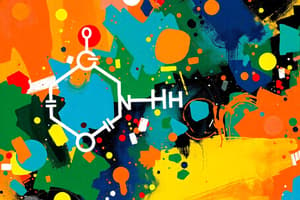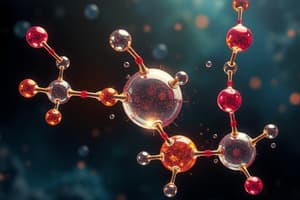Podcast
Questions and Answers
Which type of solvent is more suitable for SN1 reactions?
Which type of solvent is more suitable for SN1 reactions?
- Polar aprotic solvents
- Nonpolar solvents
- Any solvent will work
- Polar protic solvents (correct)
Polar aprotic solvents exhibit hydrogen bonding.
Polar aprotic solvents exhibit hydrogen bonding.
False (B)
What is the relationship between nucleophilicity and basicity in polar aprotic solvents?
What is the relationship between nucleophilicity and basicity in polar aprotic solvents?
Nucleophilicity parallels basicity.
In SN2 reactions, the rate depends on the concentration of _____ and the nucleophile.
In SN2 reactions, the rate depends on the concentration of _____ and the nucleophile.
Match the following terms with their definitions:
Match the following terms with their definitions:
Which factor decreases nucleophilicity despite an increase in basicity?
Which factor decreases nucleophilicity despite an increase in basicity?
The first step in an SN1 reaction involves bond making before bond breaking.
The first step in an SN1 reaction involves bond making before bond breaking.
What are nonnucleophilic bases?
What are nonnucleophilic bases?
Which statement best describes the relationship between carbocation stability and the structure of alkyl halides?
Which statement best describes the relationship between carbocation stability and the structure of alkyl halides?
A strong nucleophile favors an SN1 mechanism.
A strong nucleophile favors an SN1 mechanism.
What type of carbocation cannot be stabilized by hyperconjugation?
What type of carbocation cannot be stabilized by hyperconjugation?
The stability of a carbocation is influenced by both inductive effects and __________.
The stability of a carbocation is influenced by both inductive effects and __________.
Match the following factors influencing SN1 and SN2 mechanisms with their descriptions:
Match the following factors influencing SN1 and SN2 mechanisms with their descriptions:
What is the primary characteristic of a good leaving group in nucleophilic substitution reactions?
What is the primary characteristic of a good leaving group in nucleophilic substitution reactions?
A negatively charged nucleophile is always a stronger nucleophile than its conjugate acid.
A negatively charged nucleophile is always a stronger nucleophile than its conjugate acid.
What is the effect of polar protic solvents on nucleophiles?
What is the effect of polar protic solvents on nucleophiles?
Nucleophilicity increases as basicity increases when moving from _____ to _____ across a row of the periodic table.
Nucleophilicity increases as basicity increases when moving from _____ to _____ across a row of the periodic table.
Match the following nucleophiles with their relative strength:
Match the following nucleophiles with their relative strength:
Which of the following nucleophiles is the strongest one?
Which of the following nucleophiles is the strongest one?
Strong bases are considered poor leaving groups in nucleophilic substitution reactions.
Strong bases are considered poor leaving groups in nucleophilic substitution reactions.
What is the relationship between the pKa values of conjugate acids and nucleophilicity?
What is the relationship between the pKa values of conjugate acids and nucleophilicity?
When a neutral nucleophile is used, the substitution product bears a _____ charge.
When a neutral nucleophile is used, the substitution product bears a _____ charge.
What role do counterions like Li+, Na+, or K+ play when using negatively charged nucleophiles?
What role do counterions like Li+, Na+, or K+ play when using negatively charged nucleophiles?
Which type of nucleophilic substitution mechanism is favored in a polar protic solvent?
Which type of nucleophilic substitution mechanism is favored in a polar protic solvent?
SN2 reaction mechanisms involve a two-step process.
SN2 reaction mechanisms involve a two-step process.
What is the primary factor that influences the stability of a carbocation?
What is the primary factor that influences the stability of a carbocation?
In nucleophilic substitution reactions, a good leaving group is typically a __________ ion.
In nucleophilic substitution reactions, a good leaving group is typically a __________ ion.
Match the following nucleophiles with their characteristics:
Match the following nucleophiles with their characteristics:
Which statement accurately describes SN1 and SN2 reactions?
Which statement accurately describes SN1 and SN2 reactions?
A tertiary alkyl halide is less likely to undergo an SN1 reaction than a primary alkyl halide.
A tertiary alkyl halide is less likely to undergo an SN1 reaction than a primary alkyl halide.
What role does the nucleophile play in the nucleophilic substitution reaction?
What role does the nucleophile play in the nucleophilic substitution reaction?
The __________ effect describes how the stability of a carbocation increases with the addition of alkyl groups.
The __________ effect describes how the stability of a carbocation increases with the addition of alkyl groups.
Which of the following is a characteristic of polar aprotic solvents?
Which of the following is a characteristic of polar aprotic solvents?
Flashcards
Polar Protic Solvents
Polar Protic Solvents
Solvents that have hydrogen atoms bonded to electronegative atoms (e.g., O or N), allowing for hydrogen bonding. These solvents favour SN1 reactions.
Polar Aprotic Solvents
Polar Aprotic Solvents
Solvents that lack hydrogen atoms bonded to electronegative atoms and thus cannot form hydrogen bonds. These favor SN2 reactions.
SN1 Reaction Mechanism
SN1 Reaction Mechanism
A nucleophilic substitution reaction where bond breaking occurs before bond formation. It proceeds through a carbocation intermediate.
SN2 Reaction Mechanism
SN2 Reaction Mechanism
Signup and view all the flashcards
Nucleophilicity
Nucleophilicity
Signup and view all the flashcards
Steric Hindrance
Steric Hindrance
Signup and view all the flashcards
Rate Equation
Rate Equation
Signup and view all the flashcards
Non-nucleophilic Base
Non-nucleophilic Base
Signup and view all the flashcards
Leaving Group Ability
Leaving Group Ability
Signup and view all the flashcards
Poor vs. Good Leaving Groups
Poor vs. Good Leaving Groups
Signup and view all the flashcards
Nucleophilic Substitution
Nucleophilic Substitution
Signup and view all the flashcards
Nucleophile
Nucleophile
Signup and view all the flashcards
Nucleophilicity and Basicity
Nucleophilicity and Basicity
Signup and view all the flashcards
Nucleophile Strength (Periodic Trends)
Nucleophile Strength (Periodic Trends)
Signup and view all the flashcards
Negatively charged nucleophiles
Negatively charged nucleophiles
Signup and view all the flashcards
Neutral Nucleophile
Neutral Nucleophile
Signup and view all the flashcards
Solvent Effect (Nucleophiles)
Solvent Effect (Nucleophiles)
Signup and view all the flashcards
Alkyl Halides
Alkyl Halides
Signup and view all the flashcards
Primary Alkyl Halide (1°)
Primary Alkyl Halide (1°)
Signup and view all the flashcards
Secondary Alkyl Halide (2°)
Secondary Alkyl Halide (2°)
Signup and view all the flashcards
Tertiary Alkyl Halide (3°)
Tertiary Alkyl Halide (3°)
Signup and view all the flashcards
Halogen Symbol
Halogen Symbol
Signup and view all the flashcards
Polar C-X Bond
Polar C-X Bond
Signup and view all the flashcards
Leaving Group
Leaving Group
Signup and view all the flashcards
Elimination Reaction
Elimination Reaction
Signup and view all the flashcards
Inductive Effect
Inductive Effect
Signup and view all the flashcards
Hyperconjugation
Hyperconjugation
Signup and view all the flashcards
Carbocation Stability: Primary vs Tertiary
Carbocation Stability: Primary vs Tertiary
Signup and view all the flashcards
SN1 vs SN2: Alkyl Halide Structure
SN1 vs SN2: Alkyl Halide Structure
Signup and view all the flashcards
SN1 vs SN2: Leaving Group
SN1 vs SN2: Leaving Group
Signup and view all the flashcards
Study Notes
Alkyl Halides and Nucleophilic Substitution
- Alkyl halides are organic compounds with a halogen atom bonded to an sp³ hybridized carbon atom.
- Alkyl halides are classified as primary (1°), secondary (2°), or tertiary (3°) based on the number of carbon atoms bonded to the carbon atom with the halogen.
- The halogen atom is often represented by the symbol "X".
Physical Properties
- Alkyl halides are weak polar molecules.
- They exhibit dipole-dipole interactions due to the polar C-X bond.
- They are unable to form hydrogen bonds because the rest of the molecule only contains C-C and C-H bonds.
The Polar Carbon-Halogen Bond
- The electronegative halogen atom creates a polar C-X bond.
- This makes the carbon atom electron deficient.
- The polar C-X bond makes the carbon electrophilic in CH3X molecules.
Nucleophile
- A nucleophile is a Lewis base with a lone pair of electrons which seeks a positive charge.
- Nucleophiles can act as bases, inducing dehydrohalogenation of the alkyl halide and producing an alkene.
- Bases attack protons
- Nucleophiles attack other electron-deficient atoms (usually carbons)
The Leaving Group
- There are periodic trends in leaving group ability.
- From left to right across a period, basicity decreases, and leaving group ability increases.
- Down a column of the periodic table, basicity decreases, and leaving group ability increases.
- Poor leaving groups are strong bases.
- Good leaving groups are weak bases.
General Features of Nucleophilic Substitution
- Negatively charged nucleophiles like HO¯ and HS¯ are used as salts with Li⁺, Na⁺, or K⁺ counterions to balance the charge.
- When a neutral nucleophile is used, the substitution product bears a positive charge.
Nucleophilicity
- Nucleophilicity generally parallels basicity.
- A negatively charged nucleophile is typically a stronger nucleophile than its conjugate acid.
- Nucelophilicity generally increases with increasing basicity with the same nucleophilic atom.
- Right-to-left-across a row of the periodic table, nucleophilicity increases as electronegativity decreases.
Common Nucleophiles
- Positively charged: "OH", "OR", "CH₃COO⁻", "H₂O", "NH₃", "ROH", "RNH₂", "H₂S", and "RSH"
- Negatively charged: "N₃", "CN", "HC≡C", "Cl", "Br", "I", and "HS"
Solvent Effect on the Nucleophile
- Polar protic solvents solvent cations and anions effectively, but aprotic solvents do not solvate anions to any appreciable extent.
-
- Polar protic solvents are more suitable for S1 reactions, while aprotic solvents are used for S2 reactions.
- Polar aprotic solvents do not have O-H or N-H bonds. This makes them incapable of hydrogen bonding.
- Examples of polar aprotic solvents are acetone, acetonitrile, DMF, DMSO, and HMPA.
SN1 and SN2 Reactions (Mechanisms of Substitution)
- In SN1 reactions, the bond-making and bond-breaking steps occur at different times and involve a carbocation intermediate.
- In SN2 reactions, the bond-making and bond-breaking steps occur at the same time.
- The higher the activation energy (Eₐ), the slower the reaction rate and vice-versa.
Common Nucleophiles
- Negatively charged nucleophiles are generally strong nucleophiles.
The Nucleophile
- Nucleophilicity does not parallel basicity when steric hindrance becomes important.
- Steric hindrance decreases nucleophilicity, while it does not affect basicity.
- Sterically hindered bases are often poor nucleophiles.
Kinetics
- If a reaction involves the coming together of two molecules, the rate depends on the concentration of both reactants.
- S№1 reactions exhibit unimolecular kinetics (rate depends only on the concentration of the alkyl halide)
- S№2 reactions exhibit bimolecular kinetics (rate depends on the concentration of both the alkyl halide and the nucleophile)
The Leaving Group
- The leaving ability increases with increasing stability of the conjugate acid.
Factors Influencing The Rate of SN2 Reactions
- The number of alkyl groups attached to the carbon with the leaving group influences the rate.
Results of SN1 vs SN2 Mechanisms
- SN1 reactions are first-order, and SN2 are second-order reactions.
- SN1 reactions show racemization or no stereochemical change. SN2 reactions show inversion of configuration.
- Carbocation rearrangements are common in SN1 reactions, but not possible in SN2.
Carbocation Stability
- The order of carbocation stability is 3° > 2° > 1° > methyl.
- Alkyl groups are electron-donating groups that stabilize a positive charge.
- Stability increase with increasing number of alkyl groups.
Mechanisms
- Substitution Reactions: The replacement of one of the groups bonded to a carbon atom with a different group,
- Elimination Reactions: Formation of an alkene (double bond) by removal of a leaving group (halogen) and a hydrogen from adjacent atoms.
Substrate
- The structure of the alkyl halide is a major factor in determining whether it will undergo SN1 or SN2.
- The more substituted alkyl halides favor SN1 reactions.
- The less substituted alkyl halides favor SN2 reactions.
Nucleophilicity and Leaving group
- Strong nucleophiles favor SN2.
- Good leaving groups favor both SN1 and SN2.
Solvent
- Polar protic solvents favor SN1 reactions.
- Polar aprotic solvents favor SN2 reactions., The nature of the solvent is a factor in determining whether an SN1 or SN2 mechanism will proceed.
Stereochemistry
- SN2 reactions show inversion of configuration.
- SN1 reactions show racemization (or no stereochemical change).
Studying That Suits You
Use AI to generate personalized quizzes and flashcards to suit your learning preferences.




